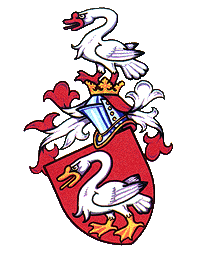Švamberks
 The Švamberks ranked
between old Czech families with an origin in the Western Bohemia at
the family seat castle Krasíkov. Origins of the Švamberks family
can be found already in the first half of the 13th. Century. In
atmosphere of ritter fashion they named themselves by germanisation
of their coat-of-arms symbol-Swan (Schwann). They penetrated the
South Bohemia during the 15th and the 16th Century, when they
obtained manors Zvíkov, Milevsko, Orlík and Bechyně. The greatest
power influence reached the Švamberks as heirs to the Rožmerks
possession.
The Švamberks ranked
between old Czech families with an origin in the Western Bohemia at
the family seat castle Krasíkov. Origins of the Švamberks family
can be found already in the first half of the 13th. Century. In
atmosphere of ritter fashion they named themselves by germanisation
of their coat-of-arms symbol-Swan (Schwann). They penetrated the
South Bohemia during the 15th and the 16th Century, when they
obtained manors Zvíkov, Milevsko, Orlík and Bechyně. The greatest
power influence reached the Švamberks as heirs to the Rožmerks
possession.
The most of the large Rožmberks possession was supposed to (according to treaty from 1484 about mutual heritages between the Rožmberks and the Švamberks), in case that one of families dies out shall after death of Petr Vok of Rožmberk pass to friendly Švamberks family, because members of both families married often with each other. At the end of the 16th Century, when was clear that matrimony of Petr Vok and Kateřina of Ludanice will stay childless, released Jan Jiří of Švamberk his justly claims for the Rožmberks heritage and called for recognition of the mutual family agreement. But chiefly he protested against legacies and sales of some of the Rožmberks manors and relation between both families were spoilt by trials, suits disputes over validity of the possession transfers. In 1597 gave Petr Vok to his nephew Jan Zrinský of Seryn, son of count Mikuláš Zrinský and sister Eva of Rožmberk, manor and castle Rožmberk and after his death also Třeboň and Vyšší Brod, what called out number of protests from landlords of Švamberk. Mutual disputes intensified after manor Český Krumlov was sold to the Emperor Rudolf II. 1601. The heritage disputes were ended by testimony of Petr Vok of Rožmberk written in 1610 at Třeboň manor. This testimony contained confirmation of transfer of castle Rožmberk to Jan Zrinský of Seryn under condition that in case of his death shall this manor obtain Jan Jiří of Švamberk.
After connecting of the Švamberks and the Rožmberks heritages the Švamberks ranked between the richest Czech nobility, because after death of Petr Vok of Rožmberk in 1611 and unexpected death of Jan Zrinský of Seryn in 1612 they obtained manors Rožmberk, Nové Hrady, Libějovice, Borovany and Třeboň with residential chateau.
 After death of Jan Jiří
of Švamberk in 1617 took over administration over family possession
his son Petr. He enforced himself as a leader of the Czech noblemen
opposition against the Emperor Ferdinand
II. Although Petr of Švamberk died in 1620, possession of
family was confiscated and manors Rožmberk and Nové Hrady gained
Karel
Bonaventura Buquoy, the Emperor´s army general.
After death of Jan Jiří
of Švamberk in 1617 took over administration over family possession
his son Petr. He enforced himself as a leader of the Czech noblemen
opposition against the Emperor Ferdinand
II. Although Petr of Švamberk died in 1620, possession of
family was confiscated and manors Rožmberk and Nové Hrady gained
Karel
Bonaventura Buquoy, the Emperor´s army general.
Coat of arms description:
The central figure of the Švamberks family is a white swan
(Schwann) with a golden beak (labium) on the red field. After
gaining the Rožmerks heritage at the beginning of the 17th Century
improve the Švamberks their coat of arms by motive from the
Rožmberks crest in the right half of divided shield.
(mj)

